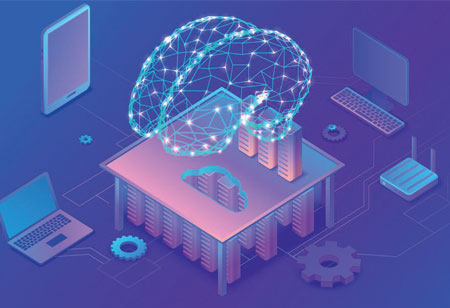
Transforming Digital Process Automation During New Normal


Dr. Kaushik Sengupta, Product Head - Food SAR Region, Bureau Veritas Group, 0
The impact of the Covid-19 pandemic has demonstrated the value of IT and digital transformation across industries and businesses are utilizing this time to speed up the transition. Pandemic gives significant changes in industries especially in technology, food delivery services, customer service, and virtual events. Research found during new normal inability to visit customers, there is a tremendous decline in sales performance, and the inability to resume production as the top negative impacts of Covid-19 on enterprise level. On the other hand, it create a bridge with new normal and enhance ability of corporate houses for a collaboration with information and technology platform, which creates wide recognition of the value of digital transformation and information technology among all employees, and the ability to market online and business development were the top positive impact.
Many companies have a digital transformation initiative in its place, but a true digital transformation always starts with a strategic mindbset towards transformation, digital culture and provides an effective customer experience. Many time companies runs in silos with disconnected or under-connected business functions and lacks driving force behind technology and decision-making ability. Customer expectations are not static and will continue to evolve with people counting on their bank to cater for them every step of the way, from mobile-first offerings and the secure handling of sensitive data, to swift and seamless processes.
There’s a lot of talk about intelligent automation, certainly. It represents a more advanced form of what is commonly known as robotic process automation. Any set of large-scale activities or groups of repetitive tasks that draw on or feed information to multiple systems are candidates for intelligent automation.
Intelligent automation is critical to a successful digital transformation, but the two terms aren’t interchangeable. Digital Transformation is bigger than the sum of its parts and essential to it is intelligent automation, which must include the following six components to be considered successful as it has Front-end digitization, Extraction and automation, Process discovery and documentation, Straight through processing, Analytics and Change management.
Digital transformation goes by a lot of names like ‘Digital Process Automation,’, Analyst call it ‘Digital Operations’ or ‘intelligent Business Process Management System . And some as just ‘Process Automaton.’ The executives surveyed believe that working from home will outlast the pandemic and continue well into the future. Some 64 percent of their employees are working primarily from home now, a nine fold jump from the number prior to the pandemic. Companies giving their employees a computer and an Internet connection but keeping them productive, secure, and working in agile teams from home is more challenging. In fact, the most common areas of increased technology investment serve to boost the efficiency and safety of remote work.
One technique successful companies use to create the right alignment and partnership for digital is to think about new opportunities from the customer’s perspective. A key part of the focus should be on digital leadership that include a drive to create appropriate learning forums for employees across the organization. If organization is not sure where to start their digital education efforts, a good place might be with analytics training. While social, mobile, and cloud get a lot of attention, when it comes to gaps in digital acumen, it’s all about the data. As per a study by HBS Close to three quarters (73 percent) rated analytics as extremely important to their area of the business (8-10 on a 10-point scale), with another 17 percent rating it as important (6-7). But only a fifth (20 percent) rated their own knowledge and skills in this area highly.
The Foundation
Even before the pandemic technological progress were especially salient. Technology was disrupting production processes, especially through the rapid scale-up of digital platforms. Digital technology has been challenging with traditional boundaries with changing global value chains and the geography of jobs. After all, technology decreases the costs of doing business,
complementing investments in infrastructure, free trade agreements, and other liberalization efforts to reduce trade barriers, which in turn expands global value chains and changes the geography of jobs. New business models digital platform firms have been able to evolve rapidly from local startups to global behemoths, often with few employees or tangible assets. Digital platforms have enabled clusters of businesses to form in underdeveloped rural areas.
Technology created quivering shifts in all skills required to succeed in the labor market. While returns to routine, job specific skills are declining, the premium for skills that cannot be replaced by robots has been increasing; these include cognitive skills such as critical thinking, as well as socio behavioural skills such as managing and recognizing emotions that enhance teamwork. Earnings are higher for those who have a combination of these skills. HBS study indicates the evolving world of work demands adaptable skills that enable workers to transfer more easily from one task to another. Since 2001, the share of employment in occupations intensive in nonroutine cognitive and socio behavioural skills has increased from 19 percent to 23 percent in emerging economies, and from 33 percent to 41 percent in advanced economies.
What Changes required in New Normal
Pandemic will reinforce these pre existing trends and increase the urgency of corresponding policy responses. As evident Amazon and Alibaba getting even bigger and stronger as brick and mortar stores are unable to compete. Companies will invest more in their ability to conduct business over the internet to be more resilient to potential lockdowns. Some temporary jobs will also continue to grow. Firms may also have more incentive to invest in automation and restore production to shield against value chain disruption. Many businesses relying on imported inputs are facing lack of intermediate goods as value chains are disrupted. They may need to ensure that supplies are less vulnerable to travel restrictions. Digital technology is also improving people’s ability to work from home, although the amenability to remote work which depends on the type of jobs and tasks to be done, as well as digital capacity varies significantly across and within countries.

Policies to Upgrade
The rapid spread of technology accelerated by the pandemic has led to a pressing need for businesses and governments to adapt.Many businesses, especially in developing economies, are digitally disconnected. They may not have access to workers with the right skills and face challenging business environments.
Governments have an arsenal of policy options at their disposal, from incentives and regulations to infrastructure projects and taxation. Key priorities should be: 1) ramping up investment in human capital (knowledge, skills, and health) and lifelong learning if workers are to adapt to future labor markets; 2) strengthening social protections, expanding safety net coverage, and reforming financing arrangements and labor market norms to facilitate work transitions and to reduce disincentives to the creation of formal jobs; 3) ensuring affordable access to the internet while adapting regulations to confront the challenges posed by digital platforms (such as data privacy and protection and competition rules); and 4) upgrading taxation systems to address tax avoidance and to create fiscal space for universal social protection and human capital development.
So the new normal continues to evolve. Nonetheless, it clearly is here to stay, as are new technology solutions that make it possible. Even after the pandemic ends, the use of these technologies will expand beyond the pandemic response, and, if anything, will become even more widespread. Therefore, it is important for all levels of government to develop an approach that makes for not only a more technologically savvy future but one that is secure for both employers and employees.
Many companies have a digital transformation initiative in its place, but a true digital transformation always starts with a strategic mind-set towards transformation, digital culture and provides an effective customer experience
Technology created quivering shifts in all skills required to succeed in the labor market. While returns to routine, job specific skills are declining, the premium for skills that cannot be replaced by robots has been increasing; these include cognitive skills such as critical thinking, as well as socio behavioural skills such as managing and recognizing emotions that enhance teamwork. Earnings are higher for those who have a combination of these skills. HBS study indicates the evolving world of work demands adaptable skills that enable workers to transfer more easily from one task to another. Since 2001, the share of employment in occupations intensive in nonroutine cognitive and socio behavioural skills has increased from 19 percent to 23 percent in emerging economies, and from 33 percent to 41 percent in advanced economies.
What Changes required in New Normal
Pandemic will reinforce these pre existing trends and increase the urgency of corresponding policy responses. As evident Amazon and Alibaba getting even bigger and stronger as brick and mortar stores are unable to compete. Companies will invest more in their ability to conduct business over the internet to be more resilient to potential lockdowns. Some temporary jobs will also continue to grow. Firms may also have more incentive to invest in automation and restore production to shield against value chain disruption. Many businesses relying on imported inputs are facing lack of intermediate goods as value chains are disrupted. They may need to ensure that supplies are less vulnerable to travel restrictions. Digital technology is also improving people’s ability to work from home, although the amenability to remote work which depends on the type of jobs and tasks to be done, as well as digital capacity varies significantly across and within countries.

Policies to Upgrade
The rapid spread of technology accelerated by the pandemic has led to a pressing need for businesses and governments to adapt.Many businesses, especially in developing economies, are digitally disconnected. They may not have access to workers with the right skills and face challenging business environments.
Governments have an arsenal of policy options at their disposal, from incentives and regulations to infrastructure projects and taxation. Key priorities should be: 1) ramping up investment in human capital (knowledge, skills, and health) and lifelong learning if workers are to adapt to future labor markets; 2) strengthening social protections, expanding safety net coverage, and reforming financing arrangements and labor market norms to facilitate work transitions and to reduce disincentives to the creation of formal jobs; 3) ensuring affordable access to the internet while adapting regulations to confront the challenges posed by digital platforms (such as data privacy and protection and competition rules); and 4) upgrading taxation systems to address tax avoidance and to create fiscal space for universal social protection and human capital development.
So the new normal continues to evolve. Nonetheless, it clearly is here to stay, as are new technology solutions that make it possible. Even after the pandemic ends, the use of these technologies will expand beyond the pandemic response, and, if anything, will become even more widespread. Therefore, it is important for all levels of government to develop an approach that makes for not only a more technologically savvy future but one that is secure for both employers and employees.